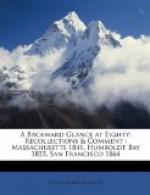Into this Resthaven it was my happy privilege to spend five-sevenths of a week of August, and the rare privilege of being obliged to do nothing was a great delight. Early rising was permissible, but not encouraged. At eight o’clock a rich Hibernian voice was heard to say, “Hot water, Mr. Murdock,” and it was so. A simple breakfast, meatless, but including the best of coffee and apricots, tree-ripened and fresh, was enjoyed at leisure undisturbed by thought of awaiting labor. Following the pleasant breakfast chat was a forenoon of converse with my friend or a friendly book or magazine, broken by a stroll through some part of the wood and introduction to the hospitably entertained trees from distant parts. My friend is something of a botanist, and was able to pronounce the court names of all his visitors. Wild flowers still persist, and among others was pointed out one which was unknown to the world till he chanced to find it.
[Illustration: OUTINGS IN THE SIERRAS, 1910 IN HAWAII, 1914]
Very interesting is the fact that the flora of the region, which is a thousand feet above sea-level, has many of the characteristics of beach vicinity, and the reason is disclosed by the outcropping at various points of a deposit of white sand, very fine, and showing under the microscope the smoothly rounded form that tells of the rolling waves. This deposit is said to be traceable for two hundred miles easterly, and where it has been eroded by the streams of today enormous trees have grown on the deposited soil. The mind is lost in conjecture of the time that must have elapsed since an ancient sea wore to infinitesimal bits the quartz that some rushing stream had brought from its native mountains.
Another interesting feature of the landscape was the clearly marked course of the old “Indian trail,” known to the earliest settlers, which followed through this region from the coast at Santa Cruz to the Santa Clara Valley. It followed the most accessible ridges and showed elemental surveying of a high order. Along its line are still found bits of rusted iron, with specks of silver, relics of the spurs and bridles of the caballeros of the early days.
The maples that sheltered the house are thinned out, that the sun may not be excluded, and until its glare becomes too radiant the steamer-chair or the rocker seeks the open that the genial page of “Susan’s Escort, and Others,” one of the inimitable books of Edward Everett Hale, may be enjoyed in comfort. When midday comes the denser shade of tree or porch is sought, and coats come off. At noon dinner is welcome, and proves that the high cost of living is largely a conventional requirement. It may be beans or a bit of roast ham brought from home, with potatoes or tomatoes, good bread and butter, and a dessert of toasted crackers with loganberries and cream. To experience the comfort of not eating too much and to find how little can be satisfying is a great lesson in the art of living. To supplement, and dispose of, this homily on food, our supper was always baked potatoes and cream toast,—but such potatoes and real cream toast! Of course, fruit was always “on tap,” and the good coffee reappeared.




